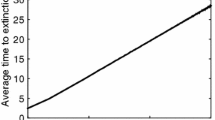Abstract
Density-independent and density-dependent, stochastic and deterministic, discrete-time, structured models are formulated, analysed and numerically simulated. A special case of the deterministic, density-independent, structured model is the well-known Leslie age-structured model. The stochastic, density-independent model is a multitype branching process. A review of linear, density-independent models is given first, then nonlinear, density-dependent models are discussed.
In the linear, density-independent structured models, transitions between states are independent of time and state. Population extinction is determined by the dominant eigenvalue λ of the transition matrix. If λ ≤ 1, then extinction occurs with probability one in the stochastic and deterministic models. However, if λ > 1, then the deterministic model has exponential growth, but in the stochastic model there is a positive probability of extinction which depends on the fixed point of the system of probability generating functions.
The linear, density-independent, stochastic model is generalized to a nonlinear, density-dependent one. The dependence on state is in terms of a weighted total population size. It is shown for small initial population sizes that the density-dependent, stochastic model can be approximated by the density-independent, stochastic model and thus, the extinction behavior exhibited by the linear model occurs in the nonlinear model. In the deterministic models there is a unique stable equilibrium. Given the population does not go extinct, it is shown that the stochastic model has a quasi-stationary distribution with mean close to the stable equilibrium, provided the population size is sufficiently large. For small values of the population size, complete extinction can be observed in the simulations. However, the persistence time increases rapidly with the population size.
Similar content being viewed by others
References
Allen, L. J. S. (1989). A density-dependent Leslie matrix model. Math. Biosci. 95, 179–187.
Block, G. L. (1998). Deterministic and stochastic nonlinear age-structured models, MSc thesis, Texas Tech University, Lubbock, TX.
Caswell, H. (1989). Matrix Population Models: Construction, Analysis, and Interpretation, Sunderland, MA: Sinauer.
Cull, P. (1986). Local and global stability for population models. Biol. Cybern. 54, 141–149.
Cushing, J. M. (1998). An Introduction to Structured Population Dynamics, CBMS-NSF Regional Conference Series in Applied Mathematics 71, Philadelphia: SIAM.
DeAngelis, D. L., L. J. Svoboda, S. W. Christensen and D. S. Vaughan (1980). Stability and return times of Leslie matrices with density-dependent survival: applications to fish populations. Ecol. Modell. 8, 149–163.
Edelstein-Keshet, L. (1988). Mathematical Models in Biology, The Random House/Birkhäuser Mathematics Series, New York: McGraw-Hill.
Gantmacher, F. R. (1964). The Theory of Matrices, New York: Chelsea Publishing Co.
Getz, W. M. (1976). Stochastic equivalents of the linear and Lotka-Volterra systems of equations—a general birth-and-death process formulation. Math. Biosci. 29, 235–237.
Getz, W. M. (1977). Control of a structured population modelled by a multivariate birth-and-death process, in Differential Games and Control Theory II, E. O. Roxin et al. (Eds), New York: Marcel Dekker, Inc., pp. 179–200.
Getz, W. M. and R. G. Haight (1989). Population Harvesting Demographic Models of Fish, Forest, and Animal Resources, Monographs in Population Biology 27, New Jersey: Princeton University Press.
Harris, T. E. (1963). The Theory of Branching Processes, Englewood Cliffs, NJ: Prentice Hall, Inc.
Jacquez, J. A. and C. P. Simon (1993). The stochastic SI model with recruitment and deaths I. Comparison with the closed SIS model. Math. Biosci. 117, 77–125.
Kot, M., M. Lewis and P. van den Driessche (1996). Dispersal data and the spread of organisms. Ecology 77, 2027–2042.
Lefkovitch, L. P. (1965). The study of population growth in organisms grouped by stages. Biometrics 21, 1–18.
Leslie, P. H. (1945). On the use of matrices in certain population mathematics. Biometrics 21, 1–18.
Leslie, P. H. (1948). Some further notes on the use of matrices in population mathematics. Biometrika 35, 213–245.
Levin, S. A. and C. P. Goodyear (1980). Analysis of an age-structured fishery model. J. Math. Biol. 9, 245–274.
Lewis, E. G. (1942). On the generation and growth of a population. Sankhya 6, 93–96.
MacArthur, R. H. and E. O. Wilson (1967). The Theory of Island Biogeography, Princeton: Princeton University Press.
Mode, C. J. (1971). Multitype Branching Processes Theory and Applications, New York: Elsevier.
Mode, C. J. (1985). Stochastic Processes in Demography and their Computer Implementation, New York: Springer-Verlag.
Nåsell, I. (1996). The quasi-stationary distribution of the closed endemic SIS model. Adv. Appl. Prob. 28, 895–932.
Nåsell, I. (1998). Quasi-stationarity and the Verhulst model. Trita-Mat-1998-23. Royal Institute of Technology: Stockholm, Sweden,.
Nåsell, I. (1999). On the quasi-stationary distribution of the stochastic logistic epidemic. Math. Biosci. 156, 21–40.
Pielou, E. C. (1977). Mathematical Ecology, New York: John Wiley & Sons.
Pollard, J. H. (1966). On the use of the direct matrix product in analyzing certain stochastic population models. Biometrika 53, 397–415.
Pollard, J. H. (1973). Mathematical Models for the Growth of Human Populations, Cambridge: Cambridge University Press.
Silva, J. A. L. and T. G. Hallam (1992). Compensation and stability in nonlinear matrix models. Math. Biosci. 110, 67–101.
Silva, J. A. L. and T. G. Hallam (1993). Effects of delay, truncations and density dependence in reproductive schedules on stability of nonlinear Leslie matrix models. J. Math. Biol. 31, 367–395.
Tognetti, K. and G. Winley (1980). Stochastic growth models with logistic mean population. J. Theor. Biol. 82, 167–169.
Tuljapurkar, S. (1990). Population Dynamics in Variable Environments, Lecture Notes in Biomathematics 85, New York: Springer-Verlag.
Wilkan, A. (1997). Dynamic consequences of reproductive delay in Leslie matrix models with nonlinear survival probabilities. Math. Biosci. 146, 37–62.
Author information
Authors and Affiliations
Corresponding author
Additional information
This author received partial support by the National Science Foundation grant # DMS-9626417.
Rights and permissions
About this article
Cite this article
Block, G.L., Allen, L.J.S. Population extinction and quasi-stationary behavior in stochastic density-dependent structured models. Bull. Math. Biol. 62, 199–228 (2000). https://doi.org/10.1006/bulm.1999.0147
Received:
Accepted:
Issue Date:
DOI: https://doi.org/10.1006/bulm.1999.0147




